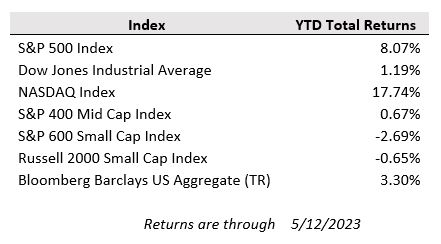Despite equity markets nearing the end of a strong first quarter corporate earnings season, concerns of lingering regional bank pressures, stubbornly high inflation expectations, and the debt ceiling standoff in Congress have collectively weighed on investor sentiment and pulled U.S. stocks lower last week. The S&P 500 and Dow Jones fell for the second consecutive week with each losing 0.3%, while the Nasdaq Composite managed to eke out a gain of 0.4%.
The debt-ceiling debate has pushed to the forefront of investor attention recently as the date that the U.S. Treasury runs out of funds to pay its obligations (referred to as the “x-date”) is approaching quickly while Congress remains at a stalemate as the situation is leveraged to advanced partisan objectives. Last week, Treasury Secretary Janet Yellen testified that the x-date could come as soon as June 1st, though quarterly corporate tax receipts in mid-June could push the deadline to late July. President Biden will be meeting with congressional leaders on Tuesday to discuss budget negotiations to avoid a default. The negotiations have gained some traction on working towards a compromise including the potential to tap unused Covid relief funds and streamline energy project permitting, among other spending measures under consideration. In the event that the debt limit is breached, the Treasury would likely seek to prioritize debt servicing payments to avoid a credit default while deferring other obligations, but a government shutdown from lack of funding would have its own set of negative economic ramifications.
While the debt ceiling has been raised or suspended over a hundred times since its creation and past instances of debt limit brinkmanship have all been resolved without lasting consequences, the risk for a technical default created by today’s standoff could introduce turbulence into financial markets as occurred in 2011. That instance of a debt ceiling showdown resulted in a ratings downgrade of U.S. credit from S&P and an equity market sell-off and flight to quality as the S&P 500 dipped nearly 17%, though the index recovered those losses within 6 months.
On a positive note, first quarter corporate earnings have well surpassed expectations overall with over 90% of S&P 500 member reports in the books so far. According to Factset, S&P 500 earnings in aggregate have exceeded forecasts by 6.6%, the highest surprise percentage since the fourth quarter of 2021, though they are still on track to decline by around 2% year-over-year against the high bar set last year. Corporate pricing power appears strong as profit margins have held up better than feared and references to inflation on earnings calls hit their lowest level going back to the second quarter of 2021, a sign of easing price pressures. Encouragingly, the strongest earnings surprises have occurred in the consumer discretionary sector, which has been an area of heightened scrutiny as pandemic stimulus savings wind down.
The consumer will remain a point of focus in the week ahead as some of the largest retailers—including Walmart, Home Depot, and Target—are set to report earnings and April retail sales will be released. Last week’s inflation readings continued to trend down with headline CPI growth decelerating to 4.9% year-over-year and producer price growth down to 2.3% year-over-year, but last week’s consumer sentiment survey from the University of Michigan showed that consumers are still feeling the pinch of higher prices and anticipating future inflation to remain elevated. This week’s retailer earnings results and commentaries will give more insight as to how these factors are impacting spending patterns.


